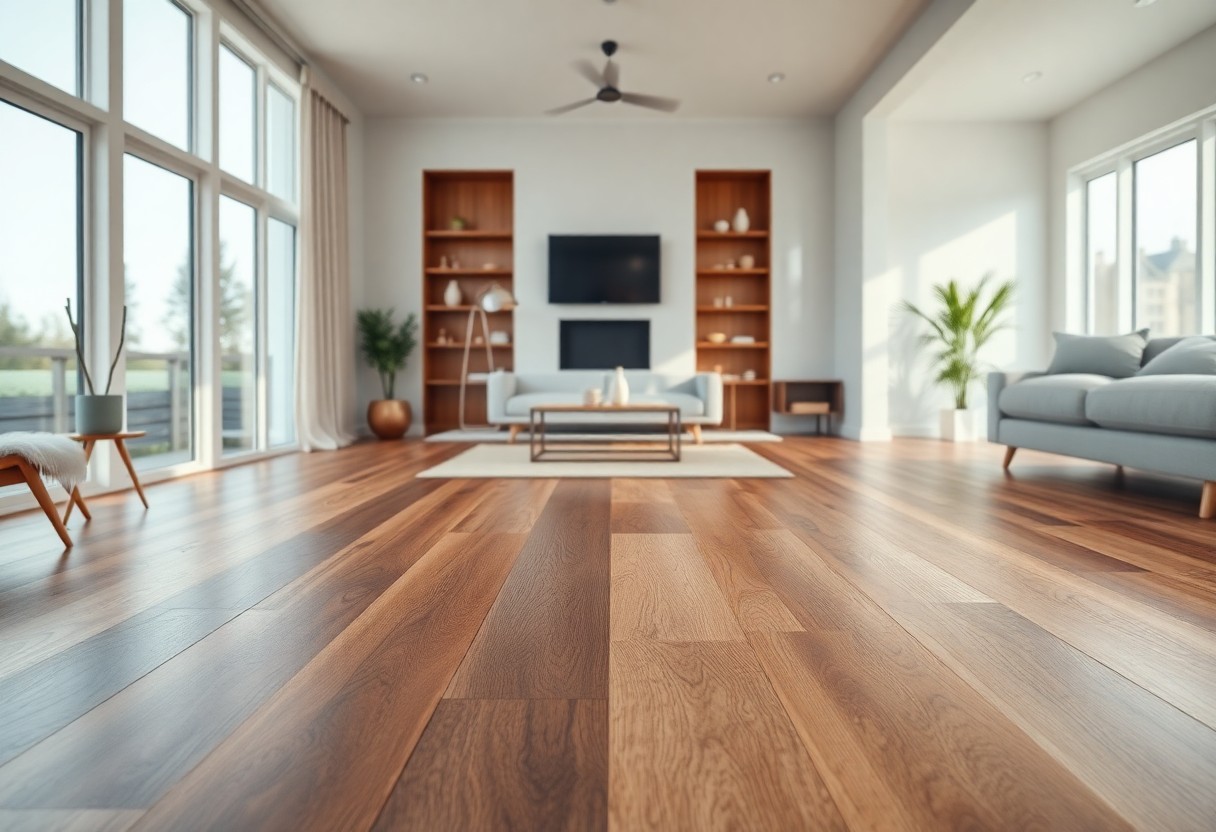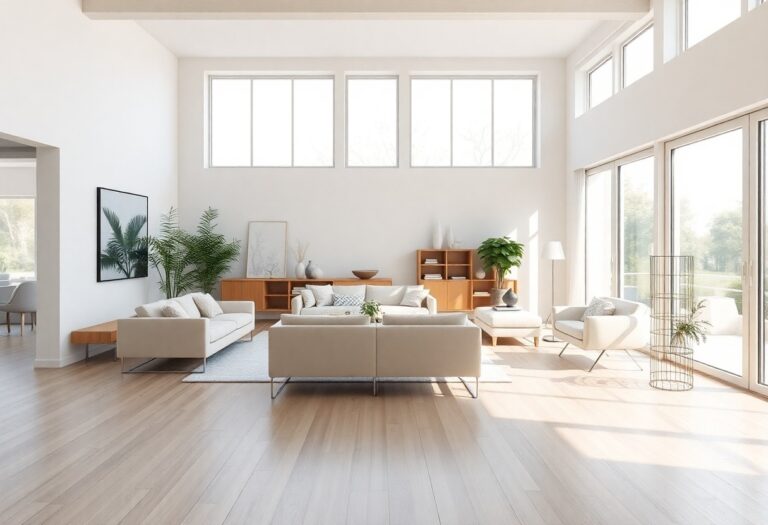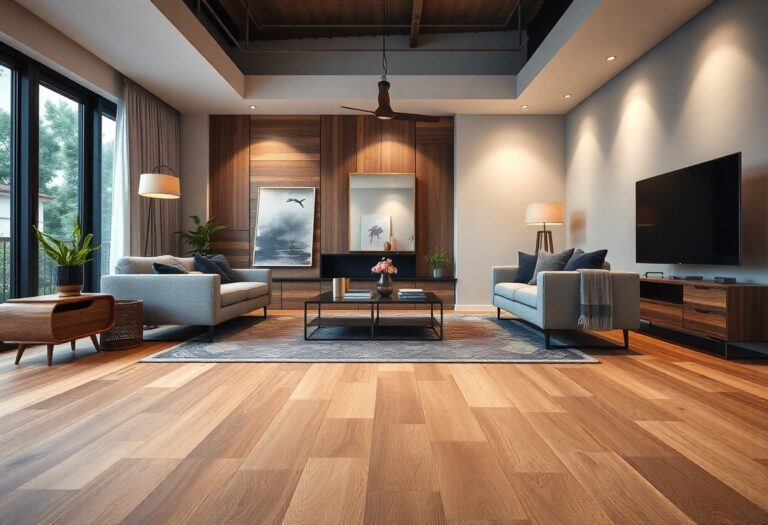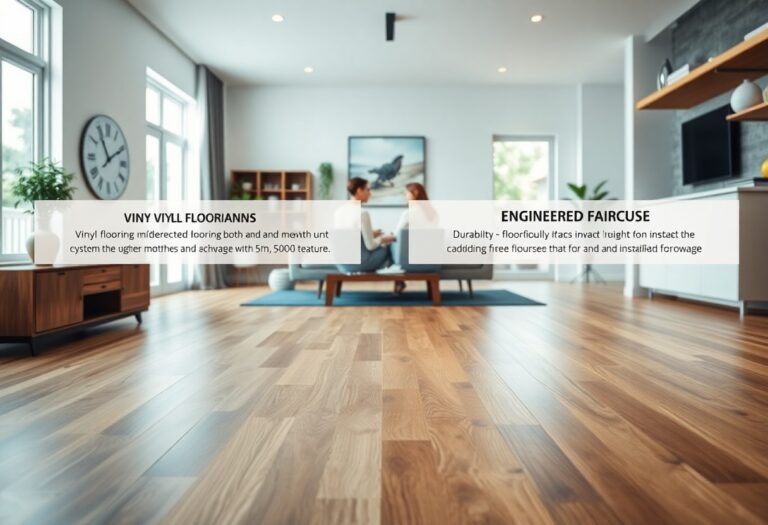There’s a lot to consider when deciding between vinyl and pre-engineered flooring for your home. Each option offers distinct advantages that can complement your lifestyle and design preferences. Understanding the differences in durability, installation, maintenance, and aesthetics will empower you to make an informed choice that aligns with your needs. This guide will help you evaluate the key factors and make the right flooring decision for your space.

Decoding Vinyl Flooring: Benefits and Drawbacks
Vinyl flooring offers a versatile solution for homeowners seeking affordability and practicality. It excels in water resistance, making it a popular choice for kitchens and bathrooms. While easy to install, the material can sometimes have a shorter lifespan compared to other flooring options and may show scratches over time. Additionally, its aesthetic appeal can vary significantly, ranging from budget-friendly options to high-end luxury vinyl tiles that mimic natural materials.
Durability and Maintenance Considerations
Vinyl flooring is designed to endure daily wear and tear, ideal for high-traffic areas. Its water-resistant surface prevents damage from spills or moisture, simplifying maintenance. Regular cleaning with a damp mop or gentle cleaner helps maintain its appearance, while avoiding harsh chemicals prolongs its lifespan. However, despite its robust nature, you should be cautious with heavy furniture, as it can dent or scratch the surface.
Aesthetic Variety and Design Flexibility
Vinyl flooring provides an extensive range of styles, colors, and textures, allowing you to achieve your desired look without breaking the bank. You can find vinyl that mimics hardwood, stone, and even tile, making it a suitable choice for any design theme, from rustic to modern. Flexible enough for residential and commercial spaces, the ability to layer it with underlayment further enhances comfort while allowing for customized installations to fit your unique space.
The Appeal of Pre-Engineered Flooring: A Deep Dive
Pre-engineered flooring combines the beauty of hardwood with practical benefits, making it a popular choice for homeowners. Its layered construction typically features a hardwood veneer over a core of plywood or high-density fiberboard, offering both aesthetic appeal and stability. This type of flooring can withstand fluctuations in humidity and temperature better than solid hardwood, making it suitable for a variety of environments. With numerous styles and finishes available, pre-engineered flooring seamlessly blends style and function, enhancing your home’s decor while providing durability for everyday use.
Structural Integrity and Longevity
You’ll find that pre-engineered flooring offers impressive structural integrity due to its multilayer construction, which resists warping and cupping over time. Designed to endure moisture fluctuations, the core layers ensure that the veneer remains intact, leading to a longer lifespan compared to solid hardwood in similar conditions. Typical warranties for pre-engineered flooring can range from 15 to 30 years, reflecting the confidence manufacturers have in their durability and performance.
Installation Process and Cost Implications
The installation of pre-engineered flooring is often simpler and more cost-effective compared to traditional hardwood. Many options come with click-lock systems, allowing for floating installations that don’t require glue or nails, thus reducing labor costs. Additionally, the average price per square foot for pre-engineered planks generally ranges from $3 to $12, depending on the quality and brand. Properly installed, pre-engineered flooring not only saves money upfront but also minimizes potential restoration costs in the future.
Choosing pre-engineered flooring can streamline the installation process significantly. Since it can be placed over most existing floors, you save on removal and preparation costs. Professionals can complete installations in a fraction of the time it takes for solid hardwood, allowing for quick home upgrades. DIY enthusiasts also appreciate the straightforward installation methods, contributing to additional cost savings. All these factors make pre-engineered flooring an attractive option for budget-conscious homeowners keen on enhancing their living spaces efficiently.
Environmental Impact: Sustainability Discussions
Evaluating the environmental impact of flooring options reveals significant considerations for sustainability and resource management. Your choice between vinyl and pre-engineered flooring affects not only your home’s aesthetics but also the planet. You’ll want to consider production practices, resource consumption, and end-of-life ramifications to align with your values of environmental stewardship.
Production Footprints and Resource Usage
Production processes for vinyl flooring often involve petrochemicals, leading to a higher carbon footprint compared to pre-engineered options. In contrast, pre-engineered wood typically uses less hardwood, conserving forests and promoting responsible sourcing. Sustainable brands often utilize reclaimed wood and eco-friendly adhesives, which can enhance your home’s environmental profile.
End-of-Life Considerations for Each Option
End-of-life scenarios for flooring materials reveal stark differences in sustainability. Vinyl flooring is often non-biodegradable and may contribute to landfill waste. Conversely, pre-engineered wood can be repurposed or recycled, allowing for environmentally friendly disposal. You’ll want to think about the long-term effects of your flooring choice, as one option offers more pathways for responsible disposal than the other.
While vinyl flooring typically ends up in landfills because of its inability to decompose, pre-engineered wood can be reused, recycled, or composted, significantly reducing its ecological footprint. Many manufacturers are adopting take-back programs for pre-engineered products, encouraging responsible end-of-life management. Furthermore, if you ever decide to renovate, salvaged wood from pre-engineered flooring can add character to new projects, reinforcing sustainable practices in home improvement.
Budget Breakdown: Calculating Costs and Value
Understanding the financial implications of both vinyl and pre-engineered flooring is necessary for making an informed decision. Evaluate not just the upfront costs, but also how each option fits into your long-term budget. Consider factors like maintenance, lifespan, and potential value added to your home. This breakdown will help you determine which flooring fits your financial landscape best, ensuring you make the most cost-effective choice for your space.
Initial Investment vs. Long-Term Savings
Your initial investment in flooring can vary significantly between vinyl and pre-engineered options due to their material and installation costs. Vinyl typically comes at a lower price point, making it budget-friendly upfront. However, pre-engineered flooring may offer better long-term value as it often lasts longer, requires less frequent replacement, and may increase your home’s resale value.
Cost Comparisons for Installation and Materials
Installation costs will also impact your overall budget. While vinyl flooring is generally easier and quicker to install, saving on labor costs, pre-engineered flooring often needs professional installation to ensure the best finish. Below is a cost comparison to help you assess your options:
Cost Comparison Table
| Flooring Type | Estimated Cost per Square Foot (Material + Installation) |
|---|---|
| Vinyl Flooring | $1.50 – $5.00 |
| Pre-Engineered Flooring | $4.00 – $10.00 |
Variables such as brand, style, and the intricacy of installation can affect these costs. Be mindful of additional expenses like underlayment and trim, which contribute to the total budget. Investing in quality materials can yield significant returns in durability and aesthetic appeal, making it worth weighing the options carefully.
Detailed Cost Comparisons for Installation and Materials
| Expense Type | Vinyl vs. Pre-Engineered Costs |
|---|---|
| Material Costs | Vinyl: $1.50 – $3.00 | Pre-Engineered: $3.50 – $8.00 |
| Installation Costs | Vinyl: $1.00 – $2.00 | Pre-Engineered: $2.00 – $5.00 |
Real-Life Applications: Tailoring Choices to Lifestyle
Choosing flooring goes beyond aesthetics; it’s about how each option aligns with your daily life. Understanding the demands of your household—considering factors like children, pets, and frequent entertaining—can significantly influence your decision. Both vinyl and pre-engineered flooring offer unique advantages based on your lifestyle, ensuring every stride in your home is matched with appropriate durability and style.
Family Needs and Activity Levels
Your family’s activity level plays a pivotal role in flooring selection. If you have young children or pets, you’ll likely prioritize durability and ease of maintenance. Vinyl flooring, known for its resilience and water resistance, can withstand spills and heavy foot traffic, while pre-engineered options provide the warmth of wood without sacrificing durability.
Space Usage: Which Flooring Fits Where?
Each area of your home has specific needs when it comes to flooring. For high-moisture zones like bathrooms or kitchens, vinyl excels due to its waterproof properties, making it the ideal choice. Meanwhile, in living areas or bedrooms, pre-engineered flooring can add elegance and a touch of warmth, elevating the space’s aesthetic.
Consider the layout of your home and how each space is utilized. In kitchens and bathrooms, where spills are more likely, vinyl’s waterproof nature is invaluable. Areas such as living rooms or bedrooms where comfort and sound absorption take precedence can benefit from the rich texture of pre-engineered wood. An open concept space might seamlessly blend both, using vinyl in high-traffic zones and pre-engineered flooring to enhance visual appeal in seating areas. By aligning your flooring choices with the specific functions of each room, you create practical yet stylish environments throughout your home.
Final Words
The decision between vinyl and pre-engineered flooring ultimately depends on your specific needs, lifestyle, and aesthetic preferences. Assess factors such as durability, moisture resistance, and ease of installation to determine which option aligns best with your home environment. Consider your budget and flooring maintenance requirements, as both materials offer distinct advantages and drawbacks. By thoughtfully evaluating these aspects, you can confidently choose the flooring solution that enhances the beauty and functionality of your living space.





